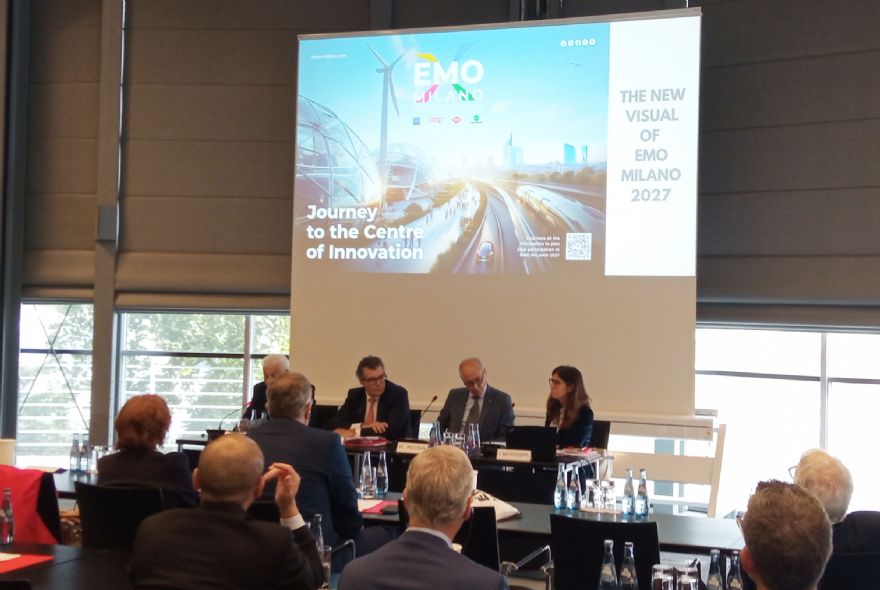 EMO Hannover 2025
EMO Hannover 2025 confirmed its status as a global hub for the machine tool, robotics and automation sectors last week, drawing 140 Italian exhibitors to the show which took place 22-26 September. Italy’s presence, second only to the host nation Germany, underscores the strategic importance of this event for manufacturers seeking international exposure and commercial opportunities. It also reflects the sector’s deep-rooted commitment to overseas markets, a theme that will carry forward to
EMO Milan 2027, scheduled for 4-8 October 2027.
During the customary press conference held at
EMO,
Ucimu-Sistemi Per Produrre, the association representing Italian manufacturers of machine tools, robots and automation systems, presented its revised 2025 industry forecasts.
Riccardo Rosa, president of Ucimu, addressed the gathered media, noting that the availability of recent data had prompted a reassessment of earlier projections. “Based on the latest order collection and the latest deliveries by Italian manufacturers, regarding the second quarter of 2025, the Economic Studies Department & Business Culture Centre had to revise the data presented just a few months ago. At the beginning of the year, we anticipated a slight growth in production supported by exports, but the current conditions of the context do not allow us to confirm this upturn today.”
Production is now expected to reach 6.34 billion euros, a marginal increase of just 0.2% over 2024, signalling a year of stagnation. This outcome is shaped by a sharp decline in exports and a sluggish domestic market. Foreign sales are forecast to fall to 3,895 billion euros, marking an 8.9% drop year-on-year. In contrast, domestic deliveries are projected to rise by 19.1% to 2,445 billion euros, buoyed by a modest recovery in consumption, which itself is expected to grow by 14.1% to 4.23 billion euros. Despite these double-digit gains, the absolute figures remain subdued.
Mr Rosa continued: “Moreover, what our Studies Centre has observed is that it is not possible to identify a clear trend for the sector. Rather, we see a pattern of upward and downward fluctuations, reflecting the chaotic situation in the context.”
Export data for the first half of 2025 reveals a 13.3% decline in Italian machine tool sales compared to the same period in 2024. The downturn was widespread, with few exceptions—namely Poland, Mexico, Switzerland, the United Arab Emirates and Saudi Arabia. However, Rosa cautioned that the latter two, despite notable growth, still represent minor markets for Italian machinery.
Challenging timesThe top five export destinations were the USA (292 million euros, -4.2%), Germany (127 million euros, -28.1%), Poland (97 million euros, +8.3%), France (97 million euros, -7.5%) and India (85 million euros, -14.1%). Mr Rosa added: “These figures highlight that Germany is suffering, and with it, Europe and Italy in particular, whose companies are integrated within German value chains.
Compared to Germany, the situation is particularly difficult both for the automotive industry – which is paying the price for the transition to electric vehicles (EVs) – and also for the crisis in the construction sector. Our hope is that the 46-billion-euro programme of the government, conceived to revitalise the Italian economy, will actually give a boost to the manufacturing industry.”
Turning to the USA, Mr Rosa noted that despite political uncertainty and tariff-related tensions, the country remains Italy’s leading export market. “Looking overseas, in the first six months of this year, despite President Trump’s numerous announcements and repeated retractions regarding tariffs, the USA remains our primary export market. The situation is rather complicated and still unclear. Apart from the tariff rates, what is most worrying is the uncertainty that it has generated in the machine tool industry. Owing to this, the entire export system has slowed down, not only for exports to the USA but also to the rest of the world.”
Domestically, Rosa observed a slight but insufficient improvement in market sentiment, aided by the clarification and simplification of Transition 5.0. He concluded: “With regard to Italy, what we observed over the last few months is a moderate but still too weak improvement in the market, which was positively affected by the clarification and simplification of Transition 5.0.
“This is also confirmed by the trend in guaranteed months of production, which did not exceed 6.6 in the first half of 2025 — it is better than in 2024 but still far from the results achieved in the previous years. In light of this, as we are approaching the final part of 2025, which coincides with the end of applicability regarding Industry 4.0 and Transition 5.0, we stress the need for a new industrial policy plan to support companies from 2026 onwards.”
Ucimu has already pledged its support to the Ministry of Enterprises and Made in Italy, joining the working group tasked with drafting a simplified measure that will merge Industry 4.0 and Transition 5.0. As announced by the Minister, this unified approach aims to streamline access for businesses, a vital step in ensuring widespread adoption and long-term competitiveness.